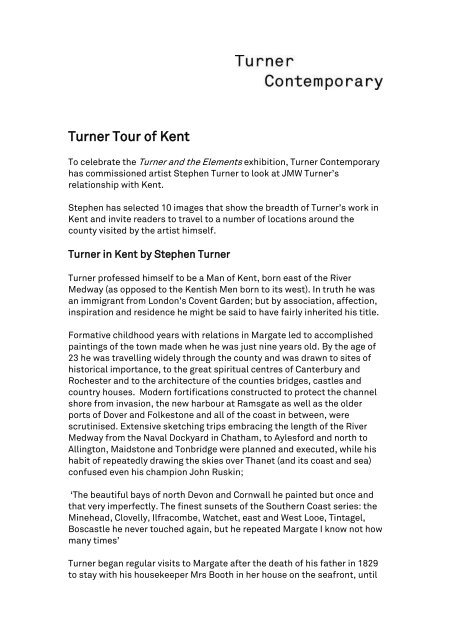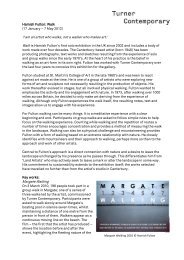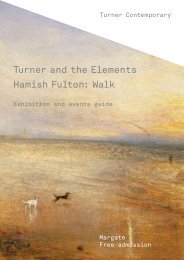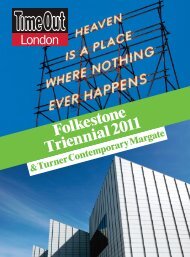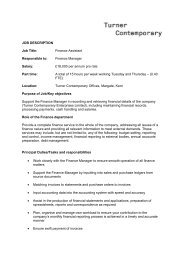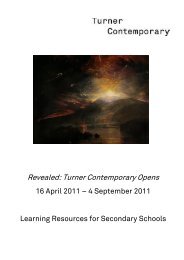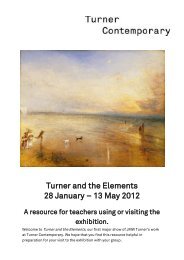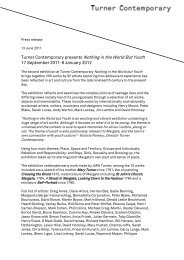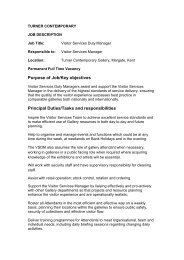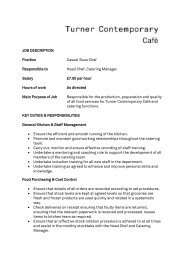Turner Tours in Kent - Turner Contemporary
Turner Tours in Kent - Turner Contemporary
Turner Tours in Kent - Turner Contemporary
You also want an ePaper? Increase the reach of your titles
YUMPU automatically turns print PDFs into web optimized ePapers that Google loves.
<strong>Turner</strong> Tour of <strong>Kent</strong><br />
To celebrate the <strong>Turner</strong> and the Elements exhibition, <strong>Turner</strong> <strong>Contemporary</strong><br />
has commissioned artist Stephen <strong>Turner</strong> to look at JMW <strong>Turner</strong>’s<br />
relationship with <strong>Kent</strong>.<br />
Stephen has selected 10 images that show the breadth of <strong>Turner</strong>’s work <strong>in</strong><br />
<strong>Kent</strong> and <strong>in</strong>vite readers to travel to a number of locations around the<br />
county visited by the artist himself.<br />
<strong>Turner</strong> <strong>in</strong> <strong>Kent</strong> by Stephen <strong>Turner</strong><br />
<strong>Turner</strong> professed himself to be a Man of <strong>Kent</strong>, born east of the River<br />
Medway (as opposed to the <strong>Kent</strong>ish Men born to its west). In truth he was<br />
an immigrant from London’s Covent Garden; but by association, affection,<br />
<strong>in</strong>spiration and residence he might be said to have fairly <strong>in</strong>herited his title.<br />
Formative childhood years with relations <strong>in</strong> Margate led to accomplished<br />
pa<strong>in</strong>t<strong>in</strong>gs of the town made when he was just n<strong>in</strong>e years old. By the age of<br />
23 he was travell<strong>in</strong>g widely through the county and was drawn to sites of<br />
historical importance, to the great spiritual centres of Canterbury and<br />
Rochester and to the architecture of the counties bridges, castles and<br />
country houses. Modern fortifications constructed to protect the channel<br />
shore from <strong>in</strong>vasion, the new harbour at Ramsgate as well as the older<br />
ports of Dover and Folkestone and all of the coast <strong>in</strong> between, were<br />
scrut<strong>in</strong>ised. Extensive sketch<strong>in</strong>g trips embrac<strong>in</strong>g the length of the River<br />
Medway from the Naval Dockyard <strong>in</strong> Chatham, to Aylesford and north to<br />
All<strong>in</strong>gton, Maidstone and Tonbridge were planned and executed, while his<br />
habit of repeatedly draw<strong>in</strong>g the skies over Thanet (and its coast and sea)<br />
confused even his champion John Rusk<strong>in</strong>;<br />
‘The beautiful bays of north Devon and Cornwall he pa<strong>in</strong>ted but once and<br />
that very imperfectly. The f<strong>in</strong>est sunsets of the Southern Coast series: the<br />
M<strong>in</strong>ehead, Clovelly, Ilfracombe, Watchet, east and West Looe, T<strong>in</strong>tagel,<br />
Boscastle he never touched aga<strong>in</strong>, but he repeated Margate I know not how<br />
many times’<br />
<strong>Turner</strong> began regular visits to Margate after the death of his father <strong>in</strong> 1829<br />
to stay with his housekeeper Mrs Booth <strong>in</strong> her house on the seafront, until
they moved together to Chelsea <strong>in</strong> 1846. His relationship with Mrs Booth<br />
rema<strong>in</strong>s uncerta<strong>in</strong>, but the view from his bedroom w<strong>in</strong>dow provided the<br />
basis for an <strong>in</strong>tense love affair with the immediate Thanet surround<strong>in</strong>gs of<br />
chalky cliffs, seas and sky.<br />
<strong>Turner</strong> also saw a more rural England of 1790 turn <strong>in</strong>to the rapidly grow<strong>in</strong>g<br />
bustle of the <strong>in</strong>dustrial urban 1840s. Margate grew from a small fish<strong>in</strong>g<br />
village to a resort with 100,000 visitors a year by the 1830s, as a newly<br />
affluent middle class augmented the leisured gentry. In <strong>Turner</strong>’s last<br />
decade, even the poor could take a tra<strong>in</strong> to the coast for a cheap holiday.<br />
William Cubitt’s n<strong>in</strong>eteen arch viaduct <strong>in</strong> Folkestone was completed <strong>in</strong><br />
1844 and there are three watercolour studies of it <strong>in</strong> <strong>Turner</strong>’s ‘Ideas of<br />
Folkestone Sketchbook’ of the follow<strong>in</strong>g year. He was <strong>in</strong>creas<strong>in</strong>gly drawn<br />
to contrast the new power of technology and eng<strong>in</strong>eer<strong>in</strong>g with the strength<br />
of natural forces and <strong>in</strong> do<strong>in</strong>g so, came to understand each the better.<br />
This selection of draw<strong>in</strong>gs, watercolours, engraved work and pa<strong>in</strong>t<strong>in</strong>g <strong>in</strong> oil<br />
illustrate different stages <strong>in</strong> <strong>Turner</strong>’s career and his deepen<strong>in</strong>g<br />
understand<strong>in</strong>g of nature and place as expressed through the microcosm of<br />
his <strong>Kent</strong>ish experience.<br />
Stephen <strong>Turner</strong><br />
For more <strong>in</strong>formation about <strong>Turner</strong> <strong>Contemporary</strong>, please visit<br />
turnercontemporary.org.
AYLESFORD<br />
Aylesford Bridge and Church, <strong>Kent</strong> ?1798<br />
Gouache, pencil and watercolour on paper support: 224 x 284 mm on paper, unique<br />
Accepted by the nation as part of the <strong>Turner</strong> Bequest 1856 D00864 F<strong>in</strong>berg number: XXXII H<br />
<strong>Turner</strong> first visited this upper tidal part of the Medway <strong>in</strong> 1797 when he made a<br />
sketch of Kits Coty, a Neolithic dolmen four miles away <strong>in</strong> the same parish. In<br />
1798 he returned and made further studies <strong>in</strong> pencil and wash of the river, church<br />
and bridge as well as this f<strong>in</strong>ished work.<br />
Gentle mid afternoon light falls across the mellow ragstone arches of the bridge,<br />
the white pa<strong>in</strong>ted gables of the cottages and the sturdy little church, to be<br />
reflected upwards aga<strong>in</strong> <strong>in</strong> the smooth undisturbed flow of the river. In the calm<br />
and unhurried quiet of the scene, two travellers pass on the bridge and seem<strong>in</strong>gly<br />
bid each other good day.<br />
Still waters run deep on the tidal Medway however. Fresh water battles with swift<br />
sal<strong>in</strong>e tides twice every day on a spot where Alfred the Great defeated the Danes,<br />
where Hengist & Horsa fought Vortigern and the Emperor Claudius crossed the<br />
Medway to defeat Caractacus and capture a K<strong>in</strong>gdom <strong>in</strong> AD43; momentous<br />
moments (which <strong>Turner</strong> could be expected to have known about) implicitly<br />
remembered, <strong>in</strong> the weathered stone of an aged bridge and the timeless flow of<br />
water beneath it.<br />
<strong>Turner</strong> has pa<strong>in</strong>ted the orig<strong>in</strong>al bridge constructed <strong>in</strong> 1250, before a larger central<br />
arch was added <strong>in</strong> 1810 to give us the bridge we more or less see today. The<br />
church too has swapped its tower and lost its little dormer w<strong>in</strong>dows, but the view<br />
reta<strong>in</strong>s its last<strong>in</strong>g picturesque attractiveness and all of its near legendary<br />
undercurrents.
CANTERBURY<br />
Christchurch Gate, Canterbury 1792-3<br />
Watercolour and graphite on paper support: 266 x 260 mm on paper, unique<br />
The Fitzwilliam Museum, Cambridge Wilton number: 34<br />
<strong>Turner</strong> was fasc<strong>in</strong>ated by the oldest cathedral city <strong>in</strong> England and made repeated<br />
visits to study the ancient gates to the town as well as the monuments, <strong>in</strong>terior<br />
and prec<strong>in</strong>cts of the church itself that contributed to the unique and particular<br />
energy of the city. He took a last goodbye <strong>in</strong> 1845, but this watercolour is an<br />
outcome of his first documented visit.<br />
Delicate watercolour wash and pencil are <strong>Turner</strong>’s tools to del<strong>in</strong>eate the stone<br />
traceries of the ornately crafted gateway, which had been chiselled by the<br />
cathedral’s own artists <strong>in</strong> 1517 but had begun to be softened by the weather over<br />
the ensu<strong>in</strong>g years. This work of the ra<strong>in</strong> and w<strong>in</strong>d had been aided by a<br />
Cromwellian mob that had torn down the orig<strong>in</strong>al statue of Christ from over the<br />
gate <strong>in</strong> 1642.<br />
<strong>Turner</strong> models its slightly softened and mottled contours with a sensitivity to the<br />
surface of the local stone that presages his later understand<strong>in</strong>g of erosion on the<br />
chalk cliffs just twenty miles away <strong>in</strong> Dover. The noble entrance to the spiritual<br />
doma<strong>in</strong> of the Church is also emphasised by <strong>Turner</strong>’s <strong>in</strong>clusion of the meaner,<br />
newer and secular structures to either side.<br />
Today’s gate is newer than the one which <strong>Turner</strong> encountered, for the entire<br />
façade was restored <strong>in</strong> the 1890s, while the tw<strong>in</strong> turrets <strong>Turner</strong> pa<strong>in</strong>ted were also<br />
taken down <strong>in</strong> 1830 and only replaced <strong>in</strong> 1937. The build<strong>in</strong>g to the right is<br />
recognisably the same as <strong>in</strong> <strong>Turner</strong>’s picture which was <strong>in</strong>terest<strong>in</strong>gly a tea shop <strong>in</strong><br />
1887 and is still a coffee shop today.
CHATHAM<br />
from Picturesque Views <strong>in</strong> England and Wales: Chatham, <strong>Kent</strong> 1832<br />
Intaglio pr<strong>in</strong>t on paper image: 148 x 235 mm on paper, pr<strong>in</strong>t<br />
Purchased 1986, T04588 Rawl<strong>in</strong>son number: 262<br />
When this pr<strong>in</strong>t of Chatham, <strong>Kent</strong> was published <strong>in</strong> 1832 the town had just elected<br />
its first Whig MP, hav<strong>in</strong>g benefited from the electoral reform Bill of that year<br />
which recognised Chatham’s grow<strong>in</strong>g population and economic prosperity as the<br />
home of ship repair and provision<strong>in</strong>g for the Royal Navy. <strong>Turner</strong> was a great<br />
supporter of the Reform Act and he seems to celebrate Chatham’s new status by<br />
bath<strong>in</strong>g the town and river <strong>in</strong> light.<br />
Rochester Cathedral and Castle, symbols respectively of religious authority and<br />
ancestral power, are <strong>in</strong> the background. Fort Amherst, <strong>in</strong> the foreground had been<br />
declared obsolete <strong>in</strong> 1820 and its ramparts and ditches all appear appropriately<br />
shaded. The guard positioned centre, is lean<strong>in</strong>g heavily on his musket and<br />
another soldier dallies with a woman. Both are seem<strong>in</strong>gly <strong>in</strong>different to their duty<br />
and suggest a creep<strong>in</strong>g neglect <strong>in</strong> the absence of threat; the war with France had<br />
been won <strong>in</strong> 1815 and Brita<strong>in</strong> now ruled the world’s oceans.<br />
The view is still readily identifiable today. The fort itself is be<strong>in</strong>g restored and the<br />
curve of the Medway still catches the light of the morn<strong>in</strong>g sun. The bulwark of<br />
Fort Pitt on the left of the picture is now occupied by the University for the<br />
Creative Arts which has <strong>in</strong>herited the address and its command<strong>in</strong>g views. The<br />
pen<strong>in</strong>sula of mud and marsh on the <strong>in</strong>side of the river’s loop is now the City<br />
Trad<strong>in</strong>g Estate, but local people still remember the soggy tidal morass of the<br />
former, which was only developed dur<strong>in</strong>g the 1970s. The Navy left <strong>in</strong> 1984 as<br />
Brita<strong>in</strong>’s power <strong>in</strong> the world decl<strong>in</strong>ed <strong>in</strong> our own post-<strong>in</strong>dustrial age. Chatham’s<br />
military past is now the heritage landscape of today. Napoleonic re-enactments<br />
are popular at Fort Amherst, but it’s less well known that a locally resident<br />
Chares Dickens described similar tourist scenes there early as the 1860s.
DOVER<br />
Shakespeare Cliff, Dover circa 1825<br />
Watercolour and scratch<strong>in</strong>g out on paper support: 181 x 245 mm on paper, unique<br />
The Fitzwilliam Museum, Cambridge Wilton number: 764<br />
<strong>Turner</strong> relishes the meet<strong>in</strong>g of storm cloud and cliff face, where dense, dark, ra<strong>in</strong><br />
laden mists, wreath the white chalky heights. The sea is driven <strong>in</strong>ward by the<br />
same <strong>in</strong>tense vent, scour<strong>in</strong>g the foreshore <strong>in</strong> a drama of the elements worthy of<br />
Shakespeare, whose work gave the cliff its name*. <strong>Turner</strong> always claimed to<br />
share Shakespeare’s birthday of St. George’s Day.<br />
Unpredictable channel weather and tall chalk cliffs, as much as the forts, towers<br />
and protective ditches which <strong>Turner</strong> pa<strong>in</strong>ted from the 1790s onward, were the<br />
real protectors of England dur<strong>in</strong>g the regular wars with France and Spa<strong>in</strong> which<br />
had ended just ten years before <strong>Turner</strong> made this watercolour. A mildly choppy La<br />
Manche had sunk Napoleon’s <strong>in</strong>vasion barges when they were tested off the<br />
French coast <strong>in</strong> 1806 and capricious weather as much as Drake’s navy had<br />
defeated the Armada for Elizabeth over 200 years before that.<br />
The relentless weather has cont<strong>in</strong>ued its daily exchange with the land and <strong>in</strong> the<br />
1960s f<strong>in</strong>ally removed the brow of the cliff hidden beh<strong>in</strong>d <strong>Turner</strong>’s clouds. The<br />
newspapers <strong>in</strong> the 1790s had reported a scheme by the French to <strong>in</strong>vade England<br />
via a Channel tunnel. Today the spoil from the one we constructed together was<br />
used to create Samphire Hoe just west of <strong>Turner</strong>’s view.<br />
* K<strong>in</strong>g Lear, Act IV scene VI – The Country near Dover
KNOCKHOLT<br />
A Beech Wood with Gypsies around a Camp Fire circa 1799-1801<br />
Oil on paper laid on panel support: 270 x 190 mm pa<strong>in</strong>t<strong>in</strong>g<br />
The Fitzwilliam Museum, Cambridge<br />
A contemporary of <strong>Turner</strong>’s, the artist Joseph Farr<strong>in</strong>gton, wrote <strong>in</strong> his diary of 30 th<br />
October 1799 to say that ‘<strong>Turner</strong> called. He has been <strong>in</strong> <strong>Kent</strong> pa<strong>in</strong>t<strong>in</strong>g the Beech<br />
Trees’. The early autumnal colour<strong>in</strong>g of this picture seems to fit <strong>in</strong> well with the<br />
season, but the year and the place has been subject to greater debate.<br />
Other works related <strong>in</strong> subject, medium and format have been confidently<br />
attributed to Knockholt, <strong>Kent</strong>, where <strong>Turner</strong> was known to have visited his friend<br />
the artist William Frederick Wells who lived there from 1801. Knockholt was<br />
famous for a clump of ancient beech trees and they are named on an 1806 map,<br />
close to the centre of the village and reputedly at the highest po<strong>in</strong>t <strong>in</strong> <strong>Kent</strong>;<br />
occupy<strong>in</strong>g a small hollow on top of the hill with a dewpond, where William the<br />
Conqueror once reputedly watered his horse. Accord<strong>in</strong>g to the writer Walter<br />
Jerrold (<strong>in</strong> 1914), on a clear day ‘the dome of St. Paul’s Cathedral may be seen<br />
from this spot’. Such favourable geography and legendary association might<br />
have further attracted <strong>Turner</strong>.<br />
The name knockholt is thought to be derived from Nok (corner) and Holte (Copse)<br />
which makes another connection to the large coppice trees <strong>in</strong> this work. Though<br />
such trees can live for over 800 years many of them were apparently lost <strong>in</strong> the<br />
great storm of October 1987 and only remnants can now be found along a<br />
footpath beh<strong>in</strong>d the Crown Pub.
MARGATE<br />
The New Moon; or, 'I've lost My Boat, You shan't have Your Hoop' exhibited 1840<br />
Oil on mahogany support: 654 x 813 mm frame: 960 x 1109 x 105 mm pa<strong>in</strong>t<strong>in</strong>g<br />
Accepted by the nation as part of the <strong>Turner</strong> Bequest 1856 N00526<br />
<strong>Turner</strong> found himself a place to live <strong>in</strong> Margate with a balcony seat onto his<br />
favourite shorel<strong>in</strong>e stage, where nature presented a new and dist<strong>in</strong>ctive<br />
spectacle every day. The property was almost opposite the entrance to the new<br />
<strong>Turner</strong> <strong>Contemporary</strong> Gallery and the view from his w<strong>in</strong>dow (as well as from short<br />
walks from his front door), gave him every opportunity to explore his fasc<strong>in</strong>ation<br />
with this shorel<strong>in</strong>e, sea and sky.<br />
The sun has set and is grac<strong>in</strong>g the moon with just sufficient light to stand out <strong>in</strong><br />
the dusky sky and to glisten on wet sand. A ship has left Jarvis’s Jetty (1824-51),<br />
hav<strong>in</strong>g brought a few hundred more people to holiday <strong>in</strong> town. It is steam<strong>in</strong>g out to<br />
sea with smoke from its tall stack bend<strong>in</strong>g aga<strong>in</strong>st an oppos<strong>in</strong>g northeasterly<br />
breeze, and suggest<strong>in</strong>g the threat of some weather to come. People paddle, dogs<br />
bow wow, fractious children shout, whilst waves swish and suck at the sand.<br />
There is much about transience <strong>in</strong> the picture and symbolism about people and<br />
nature <strong>in</strong> a restless, <strong>in</strong>terconnected flux.<br />
Present day sea defences, the lifeboat station and the brand new art gallery<br />
might now occupy or obscure <strong>Turner</strong>’s station po<strong>in</strong>t for the view, which is<br />
somewhere at the eastern end of the Rendezvous site, but natural erosion alone<br />
over the last 179 years would make actual comparison difficult. Around the time<br />
of sunset though, and on the first quarter of the moon, the <strong>in</strong>spiration for <strong>Turner</strong>’s<br />
perceptive vision can be glimpsed anywhere along Margate’s open seafront.
RAMSGATE<br />
from The Ports of England 1826-1828 Watercolours<br />
(D18142-D18143; D18150; D18152-D18154)<br />
Ramsgate circa 1824, Pencil and watercolour on paper support: 160 x 232 mm<br />
on paper, unique. Accepted by the nation as part of the <strong>Turner</strong> Bequest 1856<br />
D18150 F<strong>in</strong>berg number: CCVIII Q<br />
A storm is approach<strong>in</strong>g Ramsgate Harbour from the Channel, but the ships with<strong>in</strong><br />
its two protective granite arms are shielded from its grip and the lighthouse<br />
sh<strong>in</strong>es out a welcome to those still offshore. A variety of craft are head<strong>in</strong>g <strong>in</strong>to the<br />
port, but the weather is not so <strong>in</strong>clement that a small collier brig, caught up <strong>in</strong> the<br />
large break<strong>in</strong>g wave, should have thought to postpone its voyage. There is no<br />
panic to be found here, and it is an example of how <strong>Turner</strong> could depict the<br />
rout<strong>in</strong>e skill and great seamanship of local sailors and fishermen and the<br />
sturd<strong>in</strong>ess of their craft.<br />
Nature and the works of people compete; sailors with the sea, hard cut, granite<br />
stones of the new harbour aga<strong>in</strong>st batter<strong>in</strong>g spray, canvas with w<strong>in</strong>d and sunlight<br />
aga<strong>in</strong>st forbidd<strong>in</strong>g cloud <strong>in</strong> the artists own unique figure of eight composition,<br />
where all is presented <strong>in</strong>timately and endlessly <strong>in</strong>tertw<strong>in</strong>ed.<br />
Designed by the architect John Shaw (and his son) the construction of the<br />
harbour had begun <strong>in</strong> 1749. Its shape is much the same today, and given the right<br />
comb<strong>in</strong>ation of w<strong>in</strong>d and state of tide, turbulent seas still collide <strong>in</strong> the same old<br />
fashion.<br />
The entire harbour was be<strong>in</strong>g remodelled and was not completed until 1850, the<br />
year prior to <strong>Turner</strong>’s death. The current lighthouse was f<strong>in</strong>ished near the end of<br />
the project and replaced the earlier tower which <strong>Turner</strong> depicted. The Shaw’s also<br />
designed the harbour clock tower which <strong>Turner</strong> sketched around 1832 and shows<br />
his <strong>in</strong>terest <strong>in</strong> the development of the port.
RECULVER<br />
Sunset over a Calm Sea with a Sail<strong>in</strong>g Vessel, and the Coast of <strong>Kent</strong> with Reculver<br />
Church <strong>in</strong> the Distance 1796-7. Wilson Sketchbook [F<strong>in</strong>berg XXXVII] (D01118-<br />
D01174; D01177-D01246; D40762-D40763; complete)<br />
Gouache, pencil and watercolour on paper support: 113 x 93 mm on paper, unique<br />
Accepted by the nation as part of the <strong>Turner</strong> Bequest 1856, D01231, F<strong>in</strong>berg number: XXXVII 114<br />
The sun rises through banded cloud <strong>in</strong> the sky over Reculver on the north <strong>Kent</strong><br />
coast as a small ship heads west toward the Swale and the Thames, a journey<br />
<strong>Turner</strong> himself would have made many times en route from Margate. This small<br />
study (the sketchbook pages are only 113mm x93mm) is a complete composition<br />
<strong>in</strong> m<strong>in</strong>iature look<strong>in</strong>g out from low cliff tops along the foreshore over an empty<br />
look<strong>in</strong>g and unpopulated Herne Bay.<br />
The low cliffs made of soft Eocene clay and Thanet Sands have been erod<strong>in</strong>g at up<br />
to five feet a year s<strong>in</strong>ce <strong>Turner</strong>’s day and the bay has been much altered as a<br />
result. The tw<strong>in</strong>-towered church of St Mary’s at Reculver picked out aga<strong>in</strong>st the<br />
sky was already <strong>in</strong> the process of be<strong>in</strong>g abandoned to the sea <strong>in</strong> the 1790s. It was<br />
only saved when purchased by Tr<strong>in</strong>ity House <strong>in</strong> 1810, to preserve its dist<strong>in</strong>ctive<br />
outl<strong>in</strong>e as a navigation aid for mar<strong>in</strong>ers.<br />
The towers mark the western end of the Wantsum Channel, a navigable waterway<br />
until the Middle Ages, which separated the Isle of Thanet from the rest of <strong>Kent</strong>.<br />
Though by <strong>Turner</strong>’s day it was long silted up, the name was reta<strong>in</strong>ed and it is here<br />
he professed to f<strong>in</strong>d the f<strong>in</strong>est skies <strong>in</strong> Europe. The little study of the sunrise<br />
made <strong>in</strong> 1796 might have early confirmed him <strong>in</strong> this op<strong>in</strong>ion.
ROCHESTER<br />
Rochester: The Cathedral Seen beyond Build<strong>in</strong>gs from the South 1792<br />
Pencil on paper support: 275 x 214 mm on paper, unique<br />
Accepted by the nation as part of the <strong>Turner</strong> Bequest 1856<br />
D00117 F<strong>in</strong>berg number: VIII C<br />
Positioned on the lowest cross<strong>in</strong>g of the Medway, on the route of the old Roman<br />
road to Canterbury, Rochester was a convenient stag<strong>in</strong>g post between London<br />
and the heart of <strong>Kent</strong>. <strong>Turner</strong> visited on more than one occasion to exam<strong>in</strong>e both<br />
castle and cathedral, as well as the river down stream which was home to the<br />
Royal Navy <strong>in</strong> Chatham.<br />
He tucked himself out of the way on the southern side of the Cathedral to draw its<br />
tower and transept from the vic<strong>in</strong>ity of the old cloister gate. It is a delicate and<br />
tentative study <strong>in</strong> f<strong>in</strong>e pencil from an unaccustomed view, convey<strong>in</strong>g the solidity<br />
of cathedral stone as well as the lighter pattern of trees, leaves and shrubbery.<br />
It’s the k<strong>in</strong>d of draw<strong>in</strong>g he might have coloured, such as the pa<strong>in</strong>t<strong>in</strong>g of<br />
Christchurch Gate <strong>in</strong> Canterbury of about the same year.<br />
Though the scene has changed more than it <strong>in</strong>itially appears, it’s still possible to<br />
recognize the accuracy of his observations. The curve of the street is the same<br />
and the old ragstone cloister gate is still perched on the corner pretty much as<br />
<strong>Turner</strong> drew it (though the build<strong>in</strong>g beh<strong>in</strong>d has gone). <strong>Turner</strong>’s transept is without<br />
the two decorative p<strong>in</strong>nacles and slightly raised roof added by Gilbert Scott <strong>in</strong> the<br />
1880s, but the w<strong>in</strong>dow arrangements below are carefully seen. The octagonal<br />
spire on a square unadorned tower looks like that of today, but <strong>in</strong> fact this was an<br />
earlier construction demolished <strong>in</strong> 1824 and the Cathedral was then without a<br />
spire until 1904 when a similar design was re<strong>in</strong>stated. <strong>Turner</strong> himself <strong>in</strong> an<br />
engrav<strong>in</strong>g of 1832 shows he was abreast of developments, by correctly show<strong>in</strong>g<br />
the cathedral with a tower topped by four p<strong>in</strong>nacles but no spire.
WHITSTABLE<br />
from Picturesque Views on the Southern Coast of England<br />
(T04370-T04427; complete) Whitstable, <strong>Kent</strong> 1826<br />
Intaglio pr<strong>in</strong>t on paper image: 166 x 249 mm on paper, pr<strong>in</strong>t<br />
Purchased 1986 T04426 Rawl<strong>in</strong>son number: 127<br />
<strong>Turner</strong> sought out Whitstable as a subject for an engraved work <strong>in</strong> the series<br />
‘Picturesque Views on the Southern Coast of England’, for which he made an<br />
orig<strong>in</strong>al watercolour <strong>in</strong> 1824. This engraved work was published <strong>in</strong> 1826 with the<br />
<strong>in</strong>tention of mak<strong>in</strong>g the sentiment of the orig<strong>in</strong>al available to a great many more<br />
people.<br />
Tw<strong>in</strong> rows of rott<strong>in</strong>g posts mark a disused track down a slope toward the <strong>in</strong>tertidal<br />
flats of Whitstable Bay where people have gathered at low water to dredge<br />
for oysters by hand. A heavily laden cart heads up toward the firmer cliff top path<br />
but it’s hard go<strong>in</strong>g on the claggy ground and one man has to push whilst a second<br />
hauls on the horse’s bridle. Others, who have seen that the tide has turned and<br />
are end<strong>in</strong>g work for the day, follow them. It’s extremely hard work for little<br />
reward and <strong>Turner</strong> has thrown the entire dejected work force <strong>in</strong>to the downcast<br />
shadow of a pass<strong>in</strong>g storm. Whitstable alone is bathed <strong>in</strong> light, as a fast mov<strong>in</strong>g<br />
front crosses over the coast from the sea. A cyclone, a cycle of the tide and the<br />
daily round of the poor, mark a meet<strong>in</strong>g of the picturesque, with the counterpo<strong>in</strong>t<br />
of an early sort of social realism.<br />
Whitstable is still synonymous with oysters today, though the <strong>in</strong>dustrial change of<br />
<strong>Turner</strong>’s n<strong>in</strong>eteenth century almost saw it off with an <strong>in</strong>heritance of water<br />
pollution, disease and neglect by the end of the Second World War. Only <strong>in</strong> recent<br />
years have the beds been restocked and the more expensively raised oyster,<br />
become a delicacy.<br />
The w<strong>in</strong>dmill on top of Borstal Hill <strong>in</strong> <strong>Turner</strong>’s pa<strong>in</strong>t<strong>in</strong>g, is still stand<strong>in</strong>g like a<br />
small echo from the past, fac<strong>in</strong>g out to its offshore cous<strong>in</strong>s on the <strong>Kent</strong>ish Flats<br />
as we grapple with our post-<strong>in</strong>dustrial future and look aga<strong>in</strong> to harness the<br />
natural and renewable power of the w<strong>in</strong>d so evident <strong>in</strong> <strong>Turner</strong>’s vision of<br />
Whitstable too.
Stephen <strong>Turner</strong><br />
Stephen <strong>Turner</strong> is an artist whose work is concerned with aspects of time and the<br />
relationship between transience and permanence. His work often <strong>in</strong>volves<br />
spend<strong>in</strong>g long periods, not<strong>in</strong>g changes <strong>in</strong> the complex relationship between<br />
nature and the man-made. He is a graduate of Leeds University Department of<br />
F<strong>in</strong>e Art (1976) and the University of Reg<strong>in</strong>a, Canada (1979). He was Fellow <strong>in</strong><br />
Pa<strong>in</strong>t<strong>in</strong>g at Exeter College of Art & Design from 1980-82 before mov<strong>in</strong>g to London<br />
where he worked with the arts and environment charity Common Ground.<br />
He has been work<strong>in</strong>g pr<strong>in</strong>cipally as an artist s<strong>in</strong>ce 2003 with project partners<br />
<strong>in</strong>clud<strong>in</strong>g Stour Valley Arts, <strong>Turner</strong> <strong>Contemporary</strong>, Solent Centre for Architecture<br />
and Design, SAFLE (Public Art Wales), The Northern Gallery for <strong>Contemporary</strong> Art<br />
<strong>in</strong> Sunderland, University College Falmouth and Fermynwoods <strong>Contemporary</strong> Art.<br />
He has also <strong>in</strong>itiated personal works such as The Seafort Project<br />
(www.seafort.org) <strong>in</strong> 2006. He is currently a consultant for the public realm<br />
commission agency Artlands <strong>in</strong> north <strong>Kent</strong> and is a director of the Whitstable<br />
Biennale.<br />
His most recent work <strong>in</strong>cludes ‘Sedimental’ <strong>in</strong> 2011 (for Medway Council Art<br />
Development) a reflection on a fifteen year relationship with the River Medway<br />
and ‘Konský Gaštan Strom‘, for the Bridge Guard Art & Science Centre <strong>in</strong> Sturovo,<br />
Slovakia where he is <strong>in</strong>vestigat<strong>in</strong>g the cultural importance of the horse chestnut<br />
tree across Europe, until April 2012.


